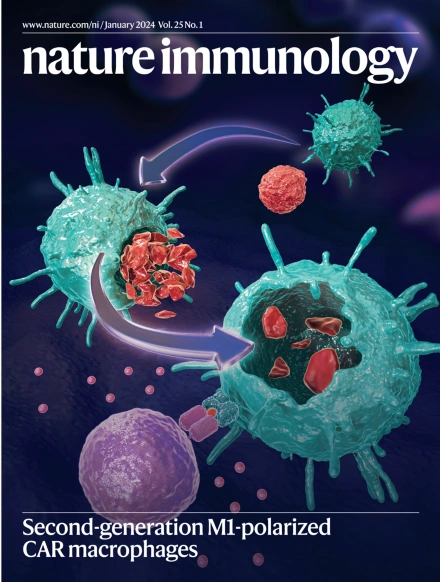共抑制受体TIGIT促进T细胞的组织保护功能。
IF 27.6
1区 医学
Q1 IMMUNOLOGY
引用次数: 0
摘要
共抑制受体TIGIT在自身免疫条件下抑制过度的免疫反应,同时也抑制抗肿瘤免疫。在病毒感染中,单独使用TIGIT不影响病毒控制,但已显示出限制组织病理。然而,其潜在的机制还不完全清楚。在这里,我们发现TIGIT+ T细胞不仅表达免疫调节基因标记,还表达组织修复基因标记。具体来说,在病毒感染后,TIGIT直接驱动组织生长因子双调节蛋白(Areg)的表达,而在没有TIGIT的情况下,Areg的表达强烈降低。我们发现调节性T (Treg)细胞,而不是CD8+ T细胞,是介导这些组织保护作用的关键T细胞亚群。在Treg细胞中,在T细胞抗原受体刺激后,TIGIT参与诱导转录因子Blimp-1,然后促进Areg的产生和组织修复。因此,我们发现了共抑制受体TIGIT的非经典功能,其中它不仅通过抑制免疫反应来限制免疫病理,而且还通过诱导T细胞中的组织生长因子Areg来积极促进组织再生。本文章由计算机程序翻译,如有差异,请以英文原文为准。
The co-inhibitory receptor TIGIT promotes tissue-protective functions in T cells.
The co-inhibitory receptor TIGIT suppresses excessive immune responses in autoimmune conditions while also restraining antitumor immunity. In viral infections, TIGIT alone does not affect viral control but has been shown to limit tissue pathology. However, the underlying mechanisms are incompletely understood. Here we found TIGIT+ T cells to express not only an immunoregulatory gene signature but also a tissue repair gene signature. Specifically, after viral infection, TIGIT directly drives expression of the tissue growth factor amphiregulin (Areg), which is strongly reduced in the absence of TIGIT. We identified regulatory T (Treg) cells, but not CD8+ T cells, as the critical T cell subset mediating these tissue-protective effects. In Treg cells, TIGIT engagement after T cell antigen receptor stimulation induces the transcription factor Blimp-1, which then promotes Areg production and tissue repair. Thus, we uncovered a nonclassical function of the co-inhibitory receptor TIGIT, wherein it not only limits immune pathology by suppressing the immune response but also actively fosters tissue regeneration by inducing the tissue growth factor Areg in T cells.
求助全文
通过发布文献求助,成功后即可免费获取论文全文。
去求助
来源期刊

Nature Immunology
医学-免疫学
CiteScore
40.00
自引率
2.30%
发文量
248
审稿时长
4-8 weeks
期刊介绍:
Nature Immunology is a monthly journal that publishes the highest quality research in all areas of immunology. The editorial decisions are made by a team of full-time professional editors. The journal prioritizes work that provides translational and/or fundamental insight into the workings of the immune system. It covers a wide range of topics including innate immunity and inflammation, development, immune receptors, signaling and apoptosis, antigen presentation, gene regulation and recombination, cellular and systemic immunity, vaccines, immune tolerance, autoimmunity, tumor immunology, and microbial immunopathology. In addition to publishing significant original research, Nature Immunology also includes comments, News and Views, research highlights, matters arising from readers, and reviews of the literature. The journal serves as a major conduit of top-quality information for the immunology community.
 求助内容:
求助内容: 应助结果提醒方式:
应助结果提醒方式:


